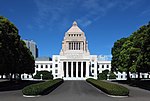National Archives of Japan

The Independent Administrative Institution National Archives of Japan (独立行政法人国立公文書館, Dokuritsu Gyosei Hojin Kokuritsu Kōbunshokan) preserve Japanese government documents and historical records and make them available to the public. Although Japan's reverence for its unique history and art is well documented and illustrated by collections of art and documents, there is almost no archivist tradition. Before the creation of the National Archives, there was a scarcity of available public documents which preserve "grey-area" records, such as internal sources to show a process which informs the formation of a specific policy or the proceedings of various committee meetings.In accordance with the National Archives Law No.79 (1999), the core function of preserving "government documents and records of importance as historical materials" includes all material relating to (1) decision-making on important items of national policies, and (2) processes of deliberation, discussion, or consultation prior to reaching any decision-making, and the process of enforcing policies based on decisions made. The transfer of what are deemed historically important materials from the various ministries and agencies is carried out on a regular basis in accordance with the Transfer Plan prepared and revised by the Prime Minister for each fiscal year. Preservation, restoration cataloging, microfilming and digitization are all important aspects of the archive's responsibilities. However, the National Archives is in the process of becoming something more than simply a historical repository, because it is also a complex of structures, processes, and epistemologies which are situated at a critical point of the intersection between scholarship, cultural practices, politics, and technologies.
Excerpt from the Wikipedia article National Archives of Japan (License: CC BY-SA 3.0, Authors, Images).National Archives of Japan
Shuto Expressway Inner Circular Route, Chiyoda
Geographical coordinates (GPS) Address External links Nearby Places Show on map
Geographical coordinates (GPS)
| Latitude | Longitude |
|---|---|
| N 35.690222222222 ° | E 139.75383333333 ° |
Address
国立公文書館
Shuto Expressway Inner Circular Route
102-8322 Chiyoda
Japan
Open on Google Maps











